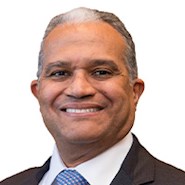
By Feniosky A. Peña-Mora, Sc.D., P.E., NAS, CCM, F.CIOB, NAC, Dist.M.ASCE
ASCE stands at the forefront of a profession that fuels communities’ economic and social engines through our leadership in shaping the built environment. As that leading voice, it is the Society’s vision that engineered and natural systems work in harmony for the benefit of humanity. When I stepped into my role as ASCE president, I shared my personal vision: “One ASCE: Together, we build a better world for all.” Over the past year, ASCE has made significant strides in bringing both visions to life.
Before my term began, we developed a new strategic plan. The 2023-2028 ASCE Strategic Plan charts a path to address the rapid changes in the profession and the world. It reinforces our role as a leader in infrastructure development and lays out strategic initiatives to position us for a better future.
To bolster these initiatives, the Reimagine ASCE Subcommittee is exploring how our organizational structure can best support the strategic plan and the evolving needs of ASCE and the profession.
The 2025 Report Card for America’s Infrastructure underscores civil engineers’ vital role in community prosperity. The report card gave our nation’s infrastructure an overall C grade — its highest ever. While this is an achievement, it reinforces the ongoing need for infrastructure investment, resilience, and sound policy. We’ve clearly communicated with policymakers the value of infrastructure funding, innovation-driven research, and data-informed decision-making. We’ve also advocated to Congress and the administration for continued support of key agencies like the National Science Foundation, NIST, FEMA, and NOAA.
To better serve our members and communities, we are transforming the practice of civil engineering. ASCE has launched several resources to help engineers adopt innovative practices and technologies. Among our most significant is ASCE AMPLIFY, a new digital platform that provides enhanced access to standards, offering artificial intelligence-powered support and side-by-side displays of provisions and commentary. More than 25 standards have already been integrated into the platform.
We’ve also created a dedicated standards office to strengthen ASCE’s position as the premier technical society for civil engineers. Our new AI Readiness Taskforce is crafting ASCE’s AI strategy while protecting the Society’s intellectual property. Additionally, the new Collaborative Innovation Team is reimagining our role as innovators in the infrastructure realm through systems integration.
As infrastructure work evolves, so does the definition of the “civil engineering team.” The field is increasingly cross-disciplinary and collaborative. ASCE must reflect this shift by embracing the broader infrastructure community and encouraging all disciplines to join. In the 2025 election, members approved a constitutional amendment to consolidate the grades of affiliate, associate, and member into a single member grade. In parallel, the Task Committee on Transforming Our Workforce has put forward recommendations to increase the number of professionals shaping the built environment.
To create this environment, we must harness the full potential of civil engineers and allied professionals through a systems-thinking approach. Supporting this is ASCE2027: The Infrastructure and Engineering Experience, a new integrated event combining the Society’s institutes’ flagship conferences. Taking place March 1-5 in Philadelphia, it will convene the brightest minds in infrastructure to explore technical content and cutting-edge cross-disciplinary topics. The call for content opens in October.
The future for ASCE and our profession is bright. Each of us can contribute to making it even brighter. Let us continue working together to build a better tomorrow for all.
Feniosky A. Peña-Mora, Sc.D., P.E., NAS, CCM, F.CIOB, NAC, Dist.M.ASCE, is the executive president for research and dean of engineering and sciences at Tec Monterrey in Mexico. He is the 2024-25 ASCE president.
This article first appeared in the September/October 2025 issue of Civil Engineering.



